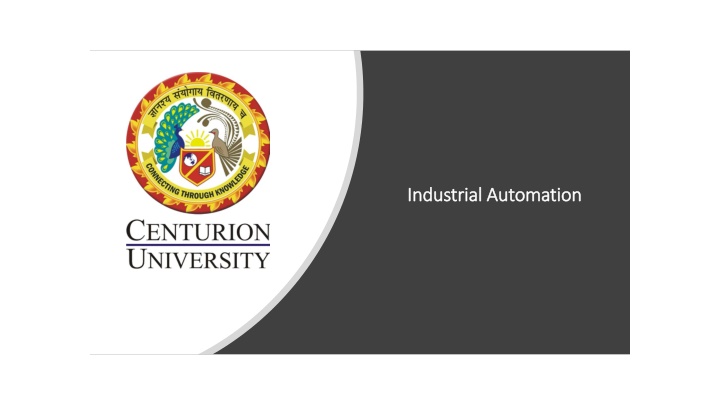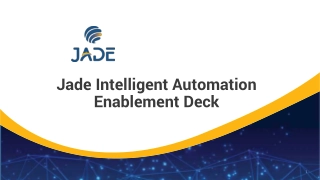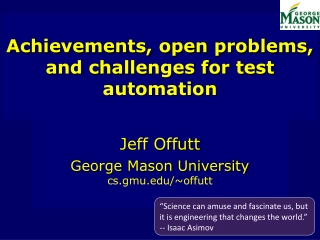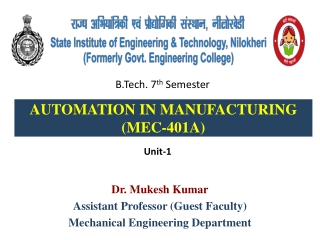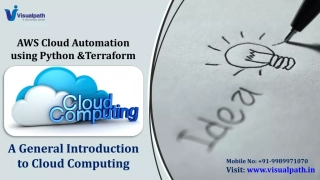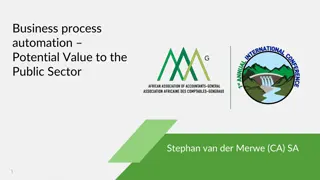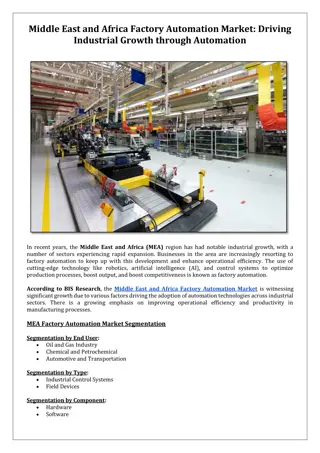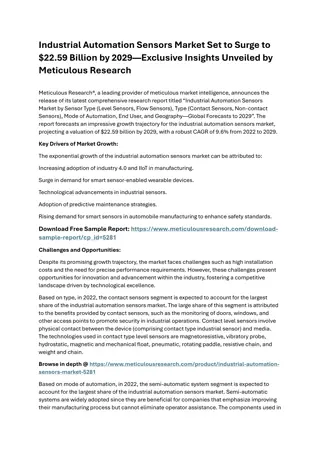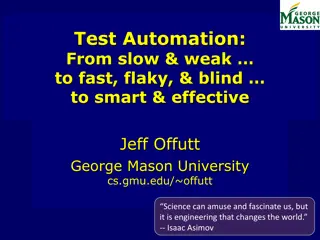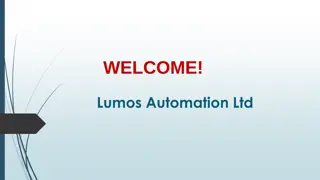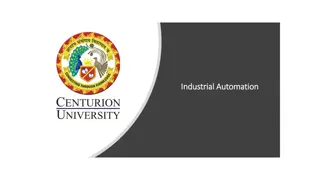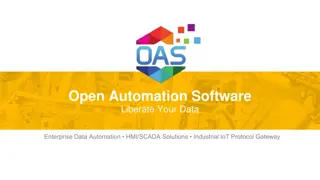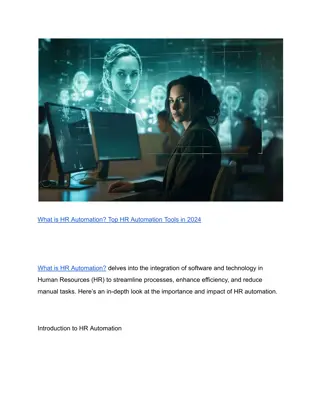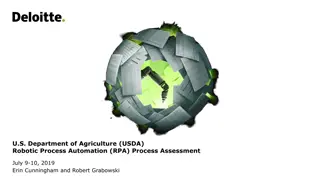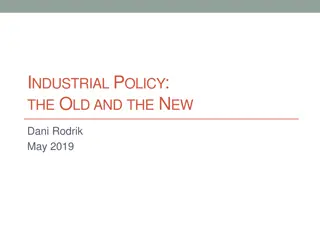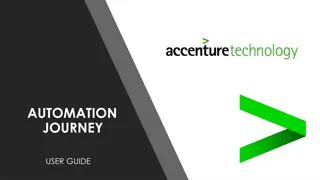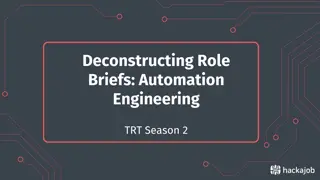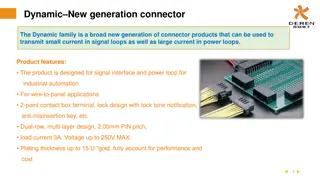Automation in Industrial Processes
Automation plays a vital role in various industries, from manufacturing to space technology. It involves delegating human control functions to technical equipment, resulting in increased productivity, improved quality, cost reduction, and enhanced safety. The history of automation traces back to different control methods like manual control, pneumatic control, hard-wired logic control, and electronic control using logic gates. Each method has its advantages and drawbacks, shaping the evolution of automation technologies over time.
Download Presentation

Please find below an Image/Link to download the presentation.
The content on the website is provided AS IS for your information and personal use only. It may not be sold, licensed, or shared on other websites without obtaining consent from the author.If you encounter any issues during the download, it is possible that the publisher has removed the file from their server.
You are allowed to download the files provided on this website for personal or commercial use, subject to the condition that they are used lawfully. All files are the property of their respective owners.
The content on the website is provided AS IS for your information and personal use only. It may not be sold, licensed, or shared on other websites without obtaining consent from the author.
E N D
Presentation Transcript
Industrial Automation Industrial Automation
Industrial Automation Automation is encompassing virtually every walk of life. Automation solutions are required right from agricultural to space technology. Plant Automation is the necessity for the manufacturing industry to survive in today s globally competitive market
What is Automation ? Automation is basically the delegation of human control function to technical equipment for Increasing Productivity Increasing Quality Reducing Cost Increasing Safety in working conditions
History of Automation Programmable Logic Controller Electronic Control using Logic Gates Hard wired logic Control Pneumatic Control Manual Control
Manual Control All the actions related to process control are taken by the operators Drawbacks Likely human errors and consequently its effect on quality of final product The production, safety, energy consumption and usage of raw material are all subject to the correctness and accuracy of human action.
Pneumatic Control Industrial automation, with its machine and process control, had its origin in the 1920s with the advent of "Pneumatic Controllers". Actions were controlled by a simple manipulation of pneumatic valves, which in turn were controlled by relays and switches. Drawbacks Bulky and Complex System Involves lot of rework to implement control logic Longer project time
Hard wired logic control The contactor and Relays together with hardware timers and counters were used in achieving the desired level of automation Drawbacks Bulky panels Complex wiring Longer project time Difficult maintenance and troubleshooting
Electronic Control using Logic Gates In 1960s with the advent of electronics, the logic gates started replacing the relays and auxiliary contactors in the control circuits. The hardware timers & counters were replaced by electronic timers Advantages Reduced space requirements Energy saving Less maintenance & greater reliability Drawbacks Changes in control logic not possible More project time
Programmable Logic Controllers In 1970s with the coming of microprocessors and associated peripheral chips, the whole process of control and automation underwent a radical change. Instead of achieving the desired control or automation through physical wiring of control devices, in PLC it is achieved through a program or say software. The programmable controllers have in recent years experienced an unprecedented growth as universal element in Industrial Automation. It can be effectively used in applications ranging from simple control like replacing small number of relays to complex automation problems
Advantages of PLCs MOORE s LAW Reduced space Energy saving Ease of maintenance Economical Greater life & reliability Tremendous flexibility Shorter project time Easier storage, archiving and documentation
Industrial Automation Components FIELD INSTRUMENTS CONTROL HARDWARE CONTROL SOFTWARE
Automation : Typical installation . . . . SCADA Software Communication Cable Control Hardware Control Panel Field Cabling Junction Box Field Cabling Sensors Placed in the field
Automation : Advanced Technology . . . . SCADA Software Communication Cable Control Hardware Control Panel Field Bus Network Field Bus Scanners Field Cabling Smart Transmitters Placed in the field
Sensors ( Field Instruments ) Sensors with transmitters are the field devices placed in the field who actually sense the parameter and send the analog signal to the control hardware. The analog signals used are Ohm (RTD), mV (Thermocouple), 4-20 mA, +/-10 V, etc
Widely used Sensors ( Field Instruments ) RTD : Output in Ohms (Temperature) Thermocouples : Output in mV (Temperature) Pressure Transmitters : 4-20mA, 0-10 V .. Flow Transmitter : 4-20mA, 0-10 V .. Level Transmitter : 4-20mA, 0-10 V .. Conductivity meter : 4-20mA, 0-10 V .. Density meter : 4-20mA, 0-10 V .. pH transmitter : 4-20mA, 0-10 V .. And Many more
Leading Manufacturers in Sensors ( Field Instruments ) Fisher Rosemount Yokogawa Anderson & Housers Radix ToshBro
Control hardware Standalone PID Controllers Programmable logic controllers (PLC) Distributed Control System
Standalone PID Controllers These are the independent small hardware units which caters requirement of closed loop controls in the process. These hardware can be installed in field or in control room. These hardware can be connected on the network. Currently the controllers are available with 100s of segment and programming patterns
Typical Installations using PID Controllers Controllers placed in field RS-232 RS-485 Bus
Leading Manufacturers in PID Controllers Yokogawa ABB Moore Eurotherm ASCON Chino Bells Fuji
Programmable Logic Controllers Now a days PLCs are the most widely used control hardware in control applications. The applications ranges from standalone system for CNC machines to Hot swappable Redundant System for Critical Process Control
What Constitutes A PLC ? The PLC is programmed interface between the field I/p element like limit switches, sensors, push button and the final control elements like actuator, solenoid/control valves, drives, hooters etc PLC consist of Input Module CPU with Processor and Program memory Output module Bus System Power Supply
Configuration of PLC : Modicon Programming Terminal PC Connection Built in display for I/O (in-rack, AS-i) and Diag 8 Analog Inputs 1 Analog Output I/O Modules Up/Down Fast Counter TSX37-22 Up Counter PCMCIA communications port Unitelway Port for connection of up to 5 Slaves PCMCIA memory expansion port
Configuration of PLC : Siemens CPU I/O Modules External Power Supply
Configuration of PLC : Allen Bradley CPU I/O Modules Power Supply
Distributed I/O Modules PLC Distributed I/O scanner Data Communication Bus Distributed I/O modules
Hot Redundant System Configuration TAPS SPLITTERS Remote I/O Network FIBER OPTIC LINK
Networking of PLCs Supervisory HMI Modicon : Modbus +, Uniteleway, Ethernet Allen Bradley : DH+, DH485, Ethernet, Control Net, Devicenet Siemens : Sinec L1/L2/H1, Profibus
Programming Languages in PLCs Ladder Logic ( LAD/LD ) Structured Text ( ST) Instruction List ( IL ) Sequential Function Chart ( SFC ) Function Block Diagram ( FBD )
Supervisory Control & Data Acquisition Software FEATURES OF TYPICAL SCADA SOFTWARE DYNAMIC PROCESS GRAPHIC REAL-TIME AND HISTORICAL TRENDING ALARMS RECIPE MANAGEMENT SECURITY DEVICE CONNECTIVITY SCRIPT FOR LOGIC DEVELOPMENT DATABASE CONNECTIVITY
Some of the Leading SCADA Software WONDERWARE : INTOUCH INTELLUTION : FIX DMACS MERZ : ASPIC ALLEN BRADLEY : RSVIEW SIEMENS : WINCC GE FANUC : CIMPLICITY KPIT : ASTRA
Role of Engineers In Industrial Automation DESIGNING OF THE AUTOMATION SYSTEM ERECTION AND COMMISSIONING MAINTENANCE AND TROUBLESHOOTING OF EXISTING SYSTEM
